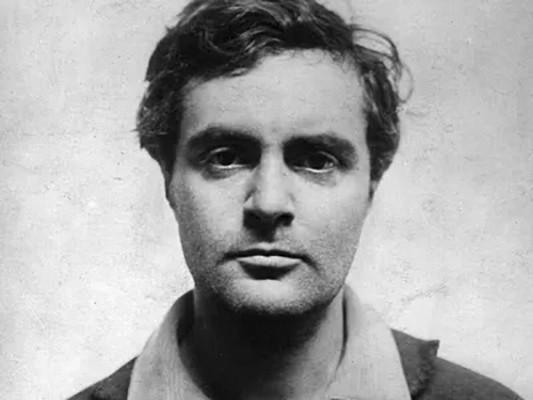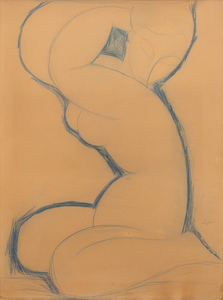AMEDEO MODIGLIANI (1884-1920)
 No matter who his models were or how conservatively they dressed, Modigliani reveled in exposing the sensuality of his female sitters. Sometimes his focus was more explicit than others. In this lovely portrait of an anonymous sitter from 1919, the artist achieves intimacy with this model by the very manner in which he applies his paint to the canvas. He renders her figure with semi-transparent, almost hesitant, brush strokes, evoking the innocence of this young girl. The formal qualities of the oil take on the luminescence of a watercolor, and the model is quite literally ‘stripped’ of any opacity.
No matter who his models were or how conservatively they dressed, Modigliani reveled in exposing the sensuality of his female sitters. Sometimes his focus was more explicit than others. In this lovely portrait of an anonymous sitter from 1919, the artist achieves intimacy with this model by the very manner in which he applies his paint to the canvas. He renders her figure with semi-transparent, almost hesitant, brush strokes, evoking the innocence of this young girl. The formal qualities of the oil take on the luminescence of a watercolor, and the model is quite literally ‘stripped’ of any opacity.
Although his portraits are considered among the finest of the 20th century, Modigliani’s working methods were unorthodox. His good looks and bacchanalian temperament sometimes intimidated his models, and his unprofessional antics would make for a lively, if not unnerving afternoon in the studio. Lunia Czechowska, one of his most frequent models, described how the artist’s joie de vivre got the better of him the first time he painted her portrait: “Gradually as the session went on and the hours passed, I was no longer afraid of him. I see him still in shirtsleeves, his hair all ruffled trying to fix my features on the canvas. From time to time he extended his hand toward a bottle of cheap table wine (vieux marc). I could see the alcohol taking effect: he was so excited he was talking with me in Italian. He painted with such violence that the painting fell over on his head has he leaned forward to see me better. I was terrified. Ashamed of having frightened me, he looked at me sweetly and began to sing Italian songs to make me forget the incident” (quoted in Pierre Sichel, A Bioghaphy of Amedeo Modigliani, New York, 1967, p. 325).
Apart from the historical influences, Modigliani was acutely aware of the artistic developments of his own time. Although he never completely subscribed to the syntax of Cubism, he adopted some of its stylistic devices, such as the geometric simplification and break-up of forms, and was close to the sculptors Ossip Zadkine and Jacques Lipchitz, both of whom were strongly influenced by Cubism. Even more important, perhaps, was his relationship with Brancusi, whom he met in 1909. Brancusi not only encouraged him to carve directly in stone, causing him to virtually abandon painting for several years, but also gave the most convincing demonstration of how influences from the widest possible range of sources-tribal, archaic, Asian and African – could be transformed into a personal idiom of the greatest originality. Although Modigliani never developed a style as close to abstraction and as far removed from the world of natural appearances as that of Brancusi, he was strongly influenced by Brancusi’s simplified forms, reducing his sitter’s faces to a few highly stylized features.

